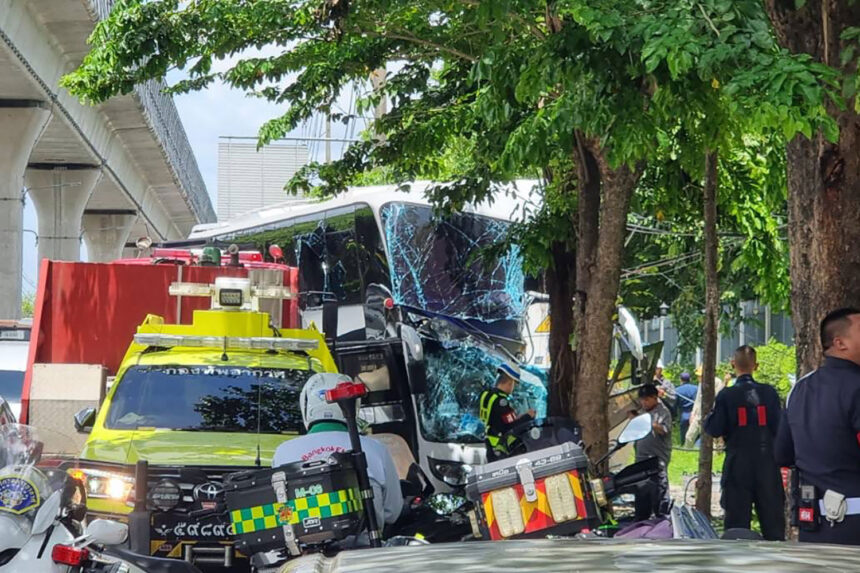BANGKOK – A tour bus transporting 45 Indian exchange students from Suvarnabhumi Airport to the Asian Institute of Technology in Pathum Thani crashed into a power pole on Phahon Yothin Road, close to the Kor Por Aor Intersection in Bangkok’s Sai Mai district, on Thursday morning.
At least 10 people were injured, including a Thai tour guide and a student who remains in critical condition. The cause of the accident has been linked to brake failure, highlighting Thailand’s ongoing struggle with road safety. The problem is just as urgent in Chiang Rai, where road crashes are common.
Reports say the bus, run by ATS Travel Group, left the road around 11 a.m. The driver, Nikom, 45, tried to avoid cars stopped at a red light. He told police, “I tried to brake, but the brakes failed.” The vehicle hit a tree before crashing into a power pole, sending smoke from the engine.
Emergency teams from Bangkhen Fire and Rescue needed half an hour to free the trapped tour guide, while other passengers got out through emergency exits. Those injured were taken to the hospital for treatment. Police are looking into what caused the mechanical problem.
Tour Bus Accidents
This incident brings attention back to Thailand’s poor road safety record. The World Health Organization’s (WHO) 2023 Global Status Report on Road Safety puts Thailand ninth out of 175 countries for road deaths, with 25.4 deaths per 100,000 people in 2021.
That adds up to around 50 deaths each day. Most victims are motorcyclists, but bus crashes like this show deeper issues with vehicle care and driver safety. The WHO points out that unsafe vehicles, dangerous driving, and weak law enforcement are behind Thailand’s high death rate.
Chiang Rai faces similar risks. Its winding roads and rural routes often see accidents, especially during busy times like Songkran. Last year, a bus crash in nearby Phayao left dozens hurt, again showing the same problems with vehicle upkeep and driver tiredness.
On average, Thailand recorded 17,914 road deaths each year from 2013 to 2023, much higher than countries like the UK, which has a similar population but far fewer fatalities.
The Thai government has started to act, but changes come slowly. The Fifth National Road Safety Master Plan (2022–2027) sets a goal to cut road deaths to 12 per 100,000 people by 2027. Steps include tougher vehicle checks, strict helmet rules, and campaigns against drink driving and speeding.
Road Safety Efforts
In Bangkok, local authorities have worked with the WHO and the Bloomberg Initiative for Global Road Safety to improve speed limit enforcement and put in new safety measures. In 2024, a new Parliamentary Advisory Group on Road Safety began working to strengthen laws and improve cooperation between agencies.
Still, big challenges remain. Many buses, especially older ones, don’t meet UNECE safety standards, and illegal upgrades are common. Corruption often weakens law enforcement, and few people know much about road safety. In Chiang Rai, there are local efforts to fix roads and put up more warning signs, but residents want better police presence and more driver education.
The Bangkok bus crash has led to renewed demands for stronger action. Prime Minister Paetongtarn Shinawatra has offered condolences and promised a full investigation.
Transport Minister Suriya Juangroongruangkit is looking at using Chinese technology to improve traffic management. For the injured Indian students, this event is a harsh introduction to travel in Thailand. For people in Chiang Rai and across the country, it’s a reminder of the urgent need to make roads safer.














